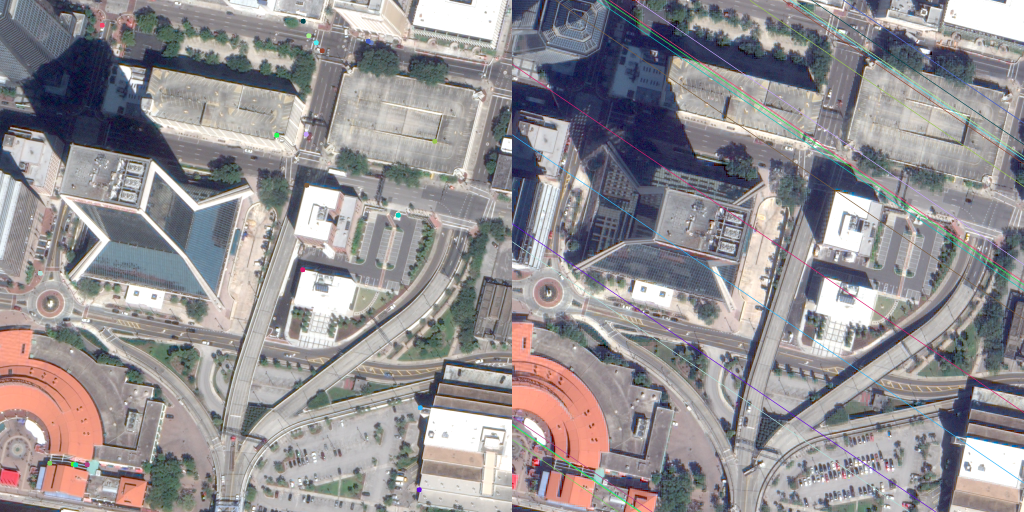Maintained by Kai Zhang.
- This is a library dedicated to solving the satellite structure from motion problem.
- It's a wrapper of the VisSatSatelliteStereo repo for easier use.
- The outputs are png images and OpenCV-compatible pinhole cameras readily deployable to multi-view stereo pipelines targetting ground-level images.
Assume you are on a Linux machine with at least one GPU, and have conda installed. Then to install this library, simply by:
. ./env.shWe assume the inputs to be a set of .tif images encoding the 3-channel uint8 RGB colors, and the metadata like RPC cameras. This data format is to align with the public satellite benchmark: TRACK 3: MULTI-VIEW SEMANTIC STEREO. Download one example data from this google drive; folder structure look like below:
- examples/inputs
- images/
- *.tif
- *.tif
- *.tif
- ...
- latlonalt_bbx.json
, where latlonalt_bbx.json specifies the bounding box for the site of interest in the global (latitude, longitude, altitude) coordinate system.
If you are not sure what is a reasonably good altitude range, you can put random numbers in the json file, but you have to enable the --use_srtm4 option below.
python satellite_sfm.py --input_folder examples/inputs --output_folder examples/outputs --run_sfm [--use_srtm4] [--enable_debug]The --enable_debug option outputs some visualization helpful debugging the structure from motion quality.
{output_folder}/images/folder contains the png images{output_folder}/cameras_adjusted/folder contains the bundle-adjusted pinhole cameras; each camera is represented by a pair of 4x4 K, W2C matrices that are OpenCV-compatible.{output_folder}/enu_bbx_adjusted.jsoncontains the scene bounding box in the local ENU Euclidean coordinate system.{output_folder}/enu_observer_latlonalt.jsoncontains the observer coordinate for defining the local ENU coordinate; essentially, this observer coordinate is only necessary for coordinate conversion between local ENU and global latitude-longitude-altitude.
If you turn on the --enable_debug option, you might want to dig into the folder {output_folder}/debug_sfm for visuals, etc.
@inproceedings{VisSat-2019,
title={Leveraging Vision Reconstruction Pipelines for Satellite Imagery},
author={Zhang, Kai and Sun, Jin and Snavely, Noah},
booktitle={IEEE International Conference on Computer Vision Workshops},
year={2019}
}
@inproceedings{schoenberger2016sfm,
author={Sch\"{o}nberger, Johannes Lutz and Frahm, Jan-Michael},
title={Structure-from-Motion Revisited},
booktitle={Conference on Computer Vision and Pattern Recognition (CVPR)},
year={2016},
}
python inspect_epipolar_geometry.py
python skew_correct.py --input_folder ./examples/outputs ./examples/outputs_zeroskew
One natural task following this SatelliteSfM is to acquire the dense reconstruction by classical patch-based MVS, or mordern deep MVS, or even neural rendering like NeRF. When working with these downstream algorithms, be careful of the float32 pitfall caused by the huge depth values as a result of satellite cameras being distant from the scene; this is particularly worthy of attention with the prevalent float32 GPU computing.
[Note: this SatelliteSfM library doesn't have such issue for the use of float64.]
Center and scale scene to be inside unit sphere by:
python normalize_sfm_reconstruction.pyModify how pixel2ray is computed for NeRF-based models, while keeping the other parts unchanged:
import torch
def pixel2ray(col: torch.Tensor, row: torch.Tensor, K: torch.DoubleTensor, W2C: torch.DoubleTensor):
'''
Assume scene is centered and inside unit sphere.
col, row: both [N, ]; float32
K, W2C: 4x4 opencv-compatible intrinsic and W2C matrices; float64
return:
ray_o, ray_d: [N, 3]; float32
'''
C2W = torch.inverse(W2C) # float64
px = torch.stack((col, row, torch.ones_like(col)), axis=-1).unsqueeze(-1) # [N, 3, 1]; float64
K_inv = torch.inverse(K[:3, :3]).unsqueeze(0).expand(px.shape[0], -1, -1) # [N, 3, 3]; float64
c2w_rot = C2W[:3, :3].unsqueeze(0).expand(px.shape[0], -1, -1) # [N, 3, 3]; float64
ray_d = torch.matmul(c2w_rot, torch.matmul(K_inv, px.double())) # [N, 3, 1]; float64
ray_d = (ray_d / ray_d.norm(dim=1, keepdims=True)).squeeze(-1) # [N, 3]; float64
ray_o = C2W[:3, 3].unsqueeze(0).expand(px.shape[0], -1) # [N, 3]; float64
# shift ray_o along ray_d towards the scene in order to shrink the huge depth
shift = torch.norm(ray_o, dim=-1) - 5. # [N, ]; float64; 5. here is a small margin
ray_o = ray_o + ray_d * shift.unsqueeze(-1) # [N, 3]; float64
return ray_o.float(), ray_d.float()JAX_168_compressed.mp4
JAX_167_compressed.mp4
JAX_166_compressed.mp4
JAX_165_compressed.mp4
JAX_164_compressed.mp4
JAX_161_compressed.mp4
JAX_156_compressed.mp4
OMA_331_compressed.mp4
OMA_383_compressed.mp4
JAX_416_compressed.mp4
to be filled...
to be filled...
Stay tuned :-)





